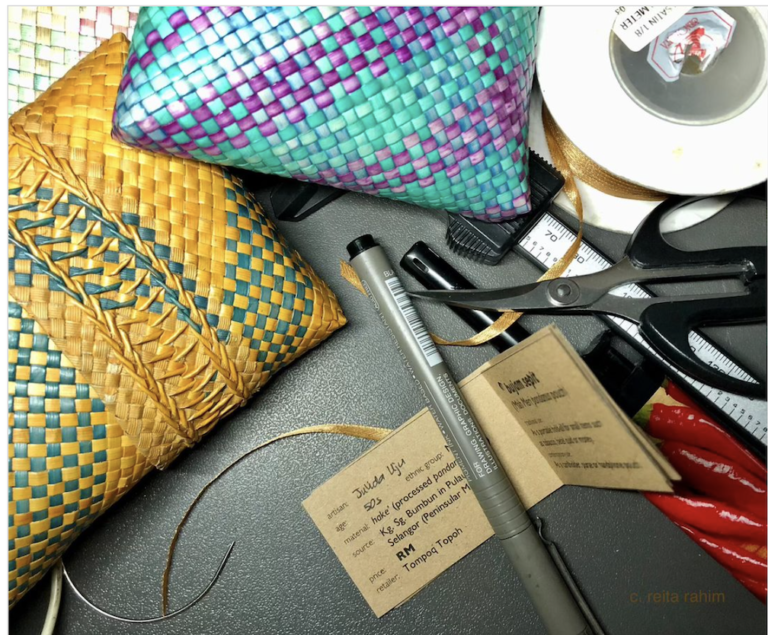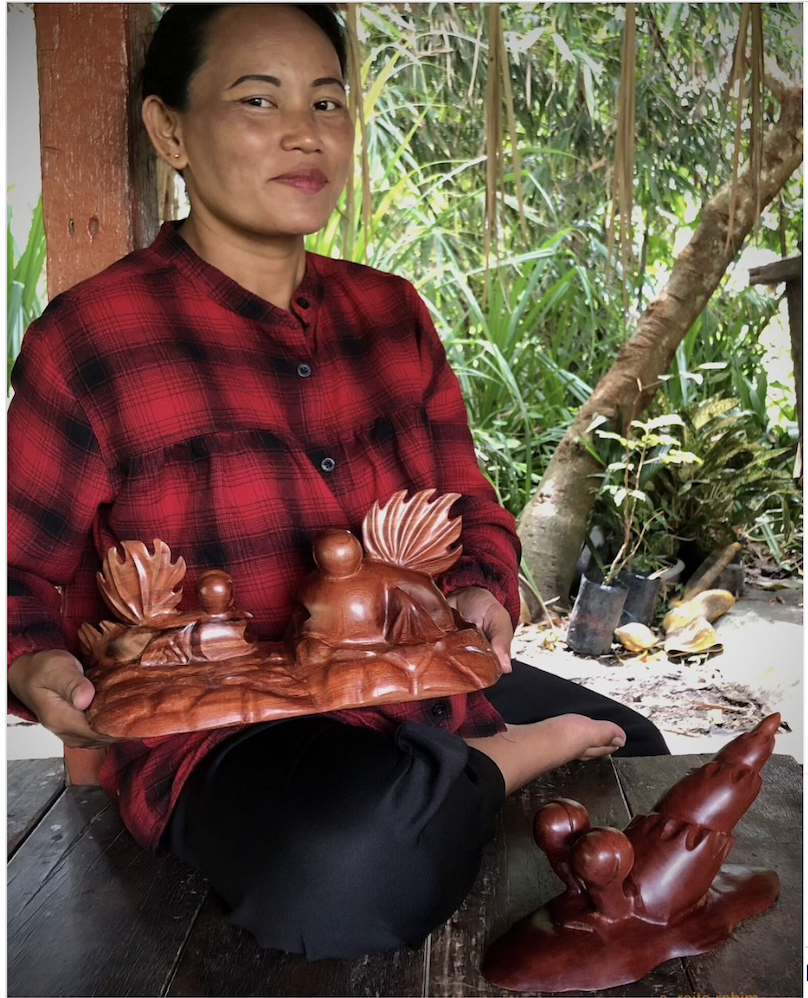October 2024 - Contemporary Orang Asli Handicrafts, Culture and Heritage

Although the Orang Asli make up only approximately 1% of the Malaysian population of roughly 35,000,000, they are the oldest inhabitants of the peninsula, some ancestors having arrived 50 to 60 thousand years ago. So, the Orang Asli are Malaysia’s indigenous people who actually make up 18 ethnic groups, living in a variety of ecological niches and speaking different languages. This contrasts with the Malays, who by some estimates arrived 6,000 years ago. The term Orang Asli, specifically, labels these people who live in the peninsula, while the indigenous people of Sabah are called Anak Negeri and those of Sarawak are the Dayak and Orang Ulu. Three broad divisions exist among the peninsula’s Orang Asli; the Negrito, the Senoi and the Aboriginal Malays. Generally, they make their homes in the centre of the peninsula, in the more uninhabitable areas. These three groups are the subject of this talk.
Our speaker was Reita Rahim, a graphic artist by training but a specialist in Orang Asal (all the indigenous groups) handicrafts. She founded Gerai OA twenty years ago to preserve the craft heritage of the minorities. As the coordinator, she helps them find and develop markets for the sale of the products of their crafts to revive and revitalize their skills. Gerai OA is a volunteer-run initiative with 100% of the monies returned to each artisan. Today she focused on their current lifestyles, culture and contemporary crafts.
Interestingly, a recently released novel in English, Slave, was originally written in Malay by Orang Asli author, Akiya (pen name of a Semai writer Mahat Cina) and released in 2013 under the title Hamba (slave in Malay). It is historical fiction examining the hard lives of Orang Asli who were abducted from their villages in the 1800s and forced to work in fields and mines by their owners. They were considered the lowest of the low and badly treated. Akiya’s desire “to share the tears, the loneliness, the tales of those called slaves: to inhabit their souls, to live among them” propelled him to tell their stories. Jason S. Ganesan is the translator and the volume is available at Gerak Budaya bookstore for RM $40.00.
The Orang Asli groups had traditional territories, mostly in Perak, Pahang and Selangor and they are involved in nomadic hunting/gathering, hunting, fishing and raising crops. The areas include wetlands in which dugout canoes are used in the shallow water and fish traps made from pandan (screw pine) are used. There is a community around Kuala Lipis and Tasek Bera, both Pahang and the Mah Meri people are found on Pulau Carey, Selangor. Mah Meri peoples were formerly sea fisherman, casting nets made using a long, unchanged technique. Their fish traps are made from bamboo.
Repositories of Orang Asli crafts can be found at the Muzium Seni Craft attached to Muzium Negara in KL, the Orang Asli Muzium (near the OA hospital in Gombak), in Malacca and in Jeti, Kelantan. Several on-line sites deal with OA; FBOA, Sejarah OA and Sahabat Rakan OA.
Reita described crafts covering every aspect of the Orang Asli daily life, mainly made from woven materials and wood. She organized the topics by examining the purpose or use of their creations.
The first craft she mentioned were those made for rituals. The Mah Meri, once fishermen, have become involved in agriculture and create the most ornate décor invoking the spirit of a female ancestor. Offerings of fish, birds and flowers represent the sea, the air and land. Leaf weavings are created by the Temiar of Gua Musang, Kelantan in the form of small, two-inch baskets put out at night when the spirits are attracted with small offerings such as cigarettes.
Healing is another area with a particular craft product, woven healing baskets made by the Jahut of Krau, Pahang.
The Jahut also prepare wooden carvings for burial. Belongings of the deceased are gathered and brought to the grave among the people in Krau, Pahang.
Sculptures as a form of art tell the stories of the Mah Meri and the Jahut in wood. A renowned sculptor, Hisham Boas from Krau was responsible for many of the Jahut pieces. He was the last sculptor from his people and has unfortunately passed away. Many of the Jahut pieces are considered effigies being a representation of what someone would look like if they came back to life.
Among the Mah Meri, wooden masks for dancing are important, especially for Hari Moyand or Spirit’s Day, when they are visited by the spirits from the other world. The hair is pleated and folded grass is used. As the older craftsmen pass on, a second generation of young boys is taking over their production.
Crafts for hunting centre around blowpipes. An unusual type of bamboo with very long spacing between nodes is searched out in Pahang. What will be the tube is cut in half, cleared and cleaned out then glued back together. Darts, tipped with poison from the Ipoh tree are scored around near the tip, are used in hunting monkeys. When struck, the monkeys will try to brush the dart off, but due to the scoring, the tip breaks off and stays in the body. Killing people is considered taboo, so they are never used for humans. The hunters are especially skilled trackers in finding their prey, to the extent that they are used as police unit trackers although they are non-confrontational. The Jakun of Pahang, used long metal tipped spears for boar hunting. In the past the metalsmiths used piston bellows to forge the tips of and a special type of charcoal for the fire, but this skill is extinct now.
Fishing crafts are important to several groups. The Temiar use fish traps. Shrimping baskets are used by the Jahut and Temiar. Foraging baskets are used by women among the Jahut and Semai to collect vegetables, durians and some leaves.
Swiddening or shifting agriculture largely related to hill rice is practiced by several groups. Rattan baskets worn on the back are used by the Jahut to collect rice in Pahang. A small finger knife was devised to help in the harvesting. In order to winnow the rice, round shallow baskets were woven.
Among the Jakun, food preparation was aided by baskets woven from bark strips.
The craft of creating fire among the Jahai involves the use of steel and quartz. The fireplaces in the wooden homes of the Semai and Semetai used for cooking, are made over a base of green leaves to keep the fire contained. Things are kept dry through smoking.
Bark cloth is made from bark which is taken off trees and is soaked and pounded. This sometimes is a trade item. Dance troupe costumes represent the identity of the performers, sometimes using a bark vest as well as other elements.
Like their bark cloth, all aspects of their clothing are made from the materials that surround them in the forest. Headgear in the form of a band is made from woven straw. Formerly they wore loin clothes whereas now some among the women wear Malay clothing, although the men have not adapted the baju melayu (Malay men’s outfit) preferring to be differentiated from the Malays. The stem and pith of the tapioca plant are used to make beads. Other adornments come from porcupine quills and hair combs are used with etched decorations. Elder men often use nose rings.
Floor mats are made from pandanus (screw pine palm) leaves.
Betel quids, the preparation used for chewing like chewing tobacco, are based on areca nuts (also called betel nuts), slaked lime and betel leaves which produce a slightly narcotic effect. The ingredients are stored in a low, open basket with a pouch for the pinang (areca nuts).
A host of musical instruments is another aspect of their crafts created largely from bamboo, while some come from wood. There are gambangs, which are basically xylophones. Nose flutes are common. Mouth harps, about three inches long made from palm, are becoming rare. Semai, Semelai and Mah Meri have stringed instruments made from bamboo, which are plucked. Even a type of violin, made from fresh stretched puffer fish, uses a stick and a coconut as a sound box.
The Orang Asli are undergoing a revival and revitalization, partly through publication of books recording their skills and crafts. Information about artists and artisans, for instance those accomplished in beading, is featured.
As the OA move into the present day, they may live in new villages set up by the British during the Emergency, referred to by the term Pos, although their spirit was frequently broken. Many villages have kindergartens but the children have to go out of their villages for further schooling. This process exposes them to bullying by others, resulting in a serious attrition rate by Form 1. Being away from their homes leads many girls to see ghosts and for girls living in dorms to experience hysteria. The young population, who are sent away to residential schools are losing their traditions, but those over 30 are clinging to their culture. Today the OA want to live on their own terms on their tanah adat (customary land) where they can live among their ancestral lands, settlements and territories.
There are several on-line sites that can be accessed for further information:
Instagram – gerai.orangasal
email – geraioa@gmail.com
FaceBook – www.facebook.com/geraioa
With many thanks to Leslie Muri for taking the time to write this detailed, informative and fascinating review.

